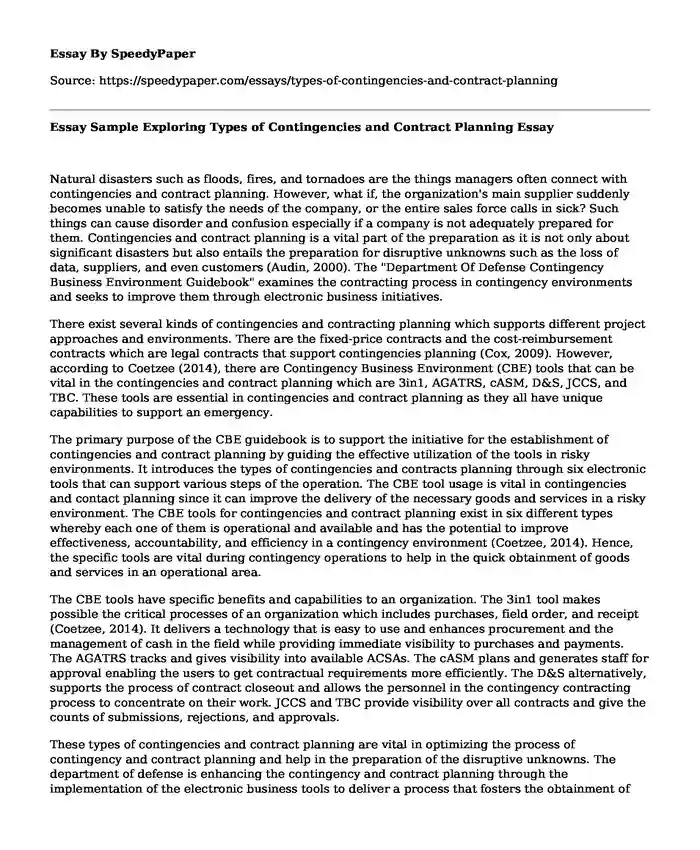
| Type of paper: | Article |
| Categories: | Contract Business law |
| Pages: | 3 |
| Wordcount: | 600 words |
Natural disasters such as floods, fires, and tornadoes are the things managers often connect with contingencies and contract planning. However, what if, the organization's main supplier suddenly becomes unable to satisfy the needs of the company, or the entire sales force calls in sick? Such things can cause disorder and confusion especially if a company is not adequately prepared for them. Contingencies and contract planning is a vital part of the preparation as it is not only about significant disasters but also entails the preparation for disruptive unknowns such as the loss of data, suppliers, and even customers (Audin, 2000). The "Department Of Defense Contingency Business Environment Guidebook" examines the contracting process in contingency environments and seeks to improve them through electronic business initiatives.
There exist several kinds of contingencies and contracting planning which supports different project approaches and environments. There are the fixed-price contracts and the cost-reimbursement contracts which are legal contracts that support contingencies planning (Cox, 2009). However, according to Coetzee (2014), there are Contingency Business Environment (CBE) tools that can be vital in the contingencies and contract planning which are 3in1, AGATRS, cASM, D&S, JCCS, and TBC. These tools are essential in contingencies and contract planning as they all have unique capabilities to support an emergency.
The primary purpose of the CBE guidebook is to support the initiative for the establishment of contingencies and contract planning by guiding the effective utilization of the tools in risky environments. It introduces the types of contingencies and contracts planning through six electronic tools that can support various steps of the operation. The CBE tool usage is vital in contingencies and contact planning since it can improve the delivery of the necessary goods and services in a risky environment. The CBE tools for contingencies and contract planning exist in six different types whereby each one of them is operational and available and has the potential to improve effectiveness, accountability, and efficiency in a contingency environment (Coetzee, 2014). Hence, the specific tools are vital during contingency operations to help in the quick obtainment of goods and services in an operational area.
The CBE tools have specific benefits and capabilities to an organization. The 3in1 tool makes possible the critical processes of an organization which includes purchases, field order, and receipt (Coetzee, 2014). It delivers a technology that is easy to use and enhances procurement and the management of cash in the field while providing immediate visibility to purchases and payments. The AGATRS tracks and gives visibility into available ACSAs. The cASM plans and generates staff for approval enabling the users to get contractual requirements more efficiently. The D&S alternatively, supports the process of contract closeout and allows the personnel in the contingency contracting process to concentrate on their work. JCCS and TBC provide visibility over all contracts and give the counts of submissions, rejections, and approvals.
These types of contingencies and contract planning are vital in optimizing the process of contingency and contract planning and help in the preparation of the disruptive unknowns. The department of defense is enhancing the contingency and contract planning through the implementation of the electronic business tools to deliver a process that fosters the obtainment of goods and services quickly and efficiently. Hence, the CBE user-friendly tools help to meet the mission fast which entails contract planning to reduce certain risks in business.
References
Audin, L. (2000). Contingencies To Build Into Your Power Contract. Strategic Planning For Energy And The Environment, 20(2), 66-71.
Coetzee, A. H. (2014). Department of Defense Contingency Business Environment Guidebook. Acquisition, Technology and Logistics.
Cox, D. (2009). Project management skills for instructional designers. Bloomington, Ind.: iUniverse Inc.
Cite this page
Essay Sample Exploring Types of Contingencies and Contract Planning. (2022, Aug 19). Retrieved from https://speedypaper.net/essays/types-of-contingencies-and-contract-planning
Request Removal
If you are the original author of this essay and no longer wish to have it published on the SpeedyPaper website, please click below to request its removal:
- Essay Example in Hispanic Culture History
- Free Essay: Exposure Routes and Health Effects of Heavy Metals on Children
- Business Ethics Essay Example: Who am I?
- Free Essay on Locus Control and Anger
- Free Essay on Problem Overview: Human Trafficking
- Essay Sample on Why Companies Conduct Cybersecurity Risk Assessment
- Paper Sample on Problems Facing Women Empowerment
Popular categories




